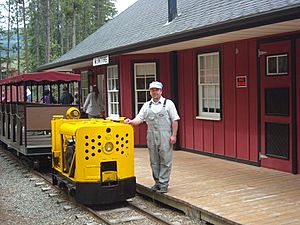MacBride Copperbelt Mining Museum facts for kids
The MacBride Copperbelt Mining Museum is a fun place in Whitehorse, Yukon, where you can learn all about mining and trains! It used to be called the Copperbelt Railway & Mining Museum. A group called the Miles Canyon Historic Railway Society (MCHRS) runs it. Their main goals are to protect Yukon's railway history, run the Waterfront Trolley, operate the museum, and help tourism in Whitehorse and the Yukon.
The museum is built on a special piece of land given by the Yukon Electrical Company in 1998. That same year, they started building a narrow-gauge train track. More sections were added over the years. By 2011, they had a 1.8 kilometer (about 1.1 mile) track shaped like a figure eight that you can ride on!
You can find the museum at 91928 Alaska Highway, about two kilometers north of Two Miles Hill. The museum building itself looks just like a train station from 1906. It's open every day from 10 AM to 5 PM, usually from early June until Labour Day weekend in September. It's a non-profit museum, which means it relies on government help and donations from visitors to keep running.
The Whitehorse Waterfront Trolley is also managed by the MCHRS. They do this for the Yukon Territorial Government.
Contents
The Story of Copper in the Yukon
The MacBride Copperbelt Mining Museum is located in an area rich with copper, about four kilometers west of Whitehorse. People first found copper here in 1898. This was when many adventurers were heading to Dawson during the Klondike Gold Rush. Most people were focused on finding gold and didn't pay much attention to the copper rocks. However, a few people decided to stay in Whitehorse and claim land for copper. Some of these early miners included John McIntyre, William P. Grainger, John Hanly, Andrew Olsen, Ole Dickson, H.E. Porter, and Sam McGee.
Early Discoveries and Miners
John McIntyre was the first to claim land for copper on July 6, 1898. He named his claim the Copper King. William P. Grainger claimed land just north of it and called his the Copper Queen. The Copper King turned out to be more successful than the Copper Queen. Because of this, Grainger bought half of the Copper King for $1,000.
Early copper mining involved looking for rocks on the surface and digging tunnels underground. Work began at the Copper King in 1899. The first shipment of ore from the Copper King was nine tons of hand-picked rock. This rock was very rich, containing 46.4% copper, 11 ounces of silver, and $2.58 worth of gold per ton. This was a very high amount of copper! Today, a typical copper mine might only have 0.4% to 1% copper in its ore.
Grainger later sold the Copper King to a group from Pennsylvania for $210,000, plus a share of future profits. Sadly, Grainger died just a few days later in the mines. He was a victim of carbon monoxide poisoning, which miners sometimes called the "black damp." This is a very dangerous gas that you cannot see or smell.
The Copperbelt Area and Mines
By 1905, nearly 500 claims had been made in the Copperbelt area. These claims covered about 260 square kilometers (100 square miles). The area stretched 20 kilometers (12 miles) from north to south, from Fish Lake to McCrae. The entire Copperbelt area is actually 30 kilometers (18.6 miles) long. It goes from south of the Klondike Highway and Alaska Highway to west of the Porter Creek neighborhood.
Moving the heavy copper ore out of the Copperbelt was very expensive. So, in 1907, construction began on a special train track called a spur line. This line would connect McCrae to the main mines. Building the 12-mile (19-kilometer) spur line was difficult. It faced many delays and work stoppages because copper prices kept changing. It was finally finished in 1910 at the Pueblo Mine.
The Pueblo Mine was the most successful of all the early copper mines. John Hanly claimed it in 1898. It was located along the Fish Lake Road. Sadly, the mine site was covered over in 1986 to make way for a fish farm called Icy Waters.
Challenges and Dangers of Mining
The mines in the Copperbelt needed a lot of wood to power their machines. For example, in 1914, the Pueblo Mine's three boilers burned 3,000 cords of wood in one year! By 1916, the Pueblo Mine was producing a lot of ore, worth $763,586. When copper prices were high, mining brought good times to Whitehorse. But when prices dropped, it caused tough times. For instance, in 1911, the population of Whitehorse dropped by 20-30% when the Pueblo Mine temporarily closed. Many people also lost their jobs at White Pass.
The worst mining accident in the Yukon happened at the Pueblo Mine in the spring of 1917. A cave-in trapped nine miners deep inside the mine, between 200 and 400 feet down. Rescuers dug an 85-foot (26-meter) tunnel through solid granite. They reached three of the miners within 72 hours. Rescue efforts continued for eight more days, but it became too dangerous. Six miners were sadly left trapped inside the mine.
An investigation found that the mine was "wet," meaning underground water built up and created huge pressure. This pressure caused the weakest part of the mine to collapse. Today, a plaque stands near the Fish Lake Road turn-off, along the Alaska Highway. It remembers the six miners who lost their lives.


